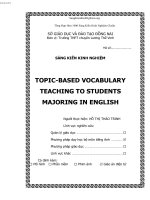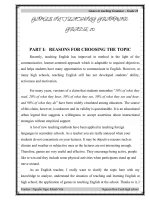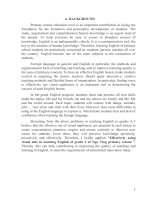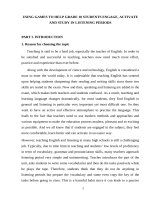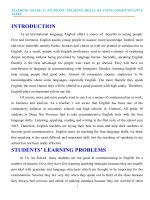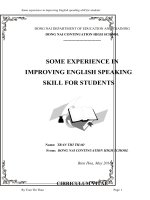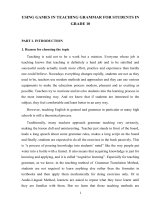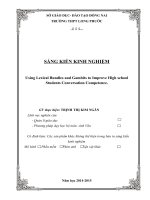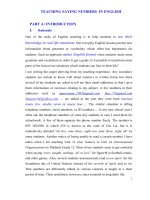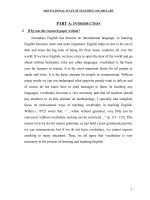skkn tiếng anh 10 USING GAMES IN TEACHING GRAMMAR FOR STUDENTS IN GRADE 10
Bạn đang xem bản rút gọn của tài liệu. Xem và tải ngay bản đầy đủ của tài liệu tại đây (336.85 KB, 33 trang )
USING GAMES IN TEACHING GRAMMAR FOR STUDENTS IN
GRADE 10
PART I. INTRODUCTION
1. Reason for choosing the topic
Teaching is said not to be a work but a mission. Everyone whose job is
teaching knows that teaching is definitely a hard job and to be satisfied and
successful needs actually much more effort, practice and experience than hardly
one could believe. Nowadays everything changes rapidly, students are not as they
used to be, teachers use modern methods and approaches and they can use various
equipments to make the education process modern, pleasant and as exciting as
possible. Teachers try to motivate and involve students into the learning process in
the most interesting way. And we know that if students are interested in the
subject, they feel comfortable and learn better in an easy way.
However, teaching English in general and grammar in particular at many high
schools is still a theoretical process.
Traditionally, many teachers approach grammar teaching very seriously,
making the lesson dull and uninteresting. Teacher just stands in front of the board,
leads a long speech about some grammar rules, makes a long script on the board
and finally, students are expected to do all the exercises in the book passively. This
is “a process of pouring knowledge into students’ mind” like the way people put
water into a bottle with a funnel. It also means that acquiring knowledge is just for
knowing and applying, and it is called “cognitive learning”. Especially for teaching
grammar, as we know, in the teaching method of Grammar Translation Method,
students are not required to learn anything else rather than the formulas in
textbooks and then apply them mechanically for doing exercises only. Or in
Audio-Lingual Method, learners are asked to repeat what they have learnt until
they are familiar with them. But we learn that those teaching methods are
1
ineffective because they cannot create an interesting atmosphere for students so
most of them get bored in grammar lessons in spite of the fact that they know these
grammar points are necessary for them.
Considering all the above situations, in this writing, I mention the application
of using games in teaching grammar at Tri An high school. And this is my reason
for choosing "Using games in teaching grammar for students of grade 10 for my
research". I hope that the result of using games in teaching grammar will bring
back many practical benefits to both the teachers and the students.
2. Aims of the study
The major aims of the study are:
- To affirm the role of grammar in teaching and learning English.
- To emphasize the importance of motivation in teaching and learning grammar.
- To point out the application of games in teaching grammar brings many benefits
to students in learning grammar.
- To contribute a small part to the improvement of teaching and learning at Tri An
high school.
3. Scope of the study
The benefits of using games in teaching grammar in textbook of English of grade
10 create the effectiveness of students’ motivation in learning grammar and the
subjects under the study are the 10th form students at Tri A high school (class
10A2).
2
4. Research questions
The study will help to find the answers to the following questions:
1. What are the role of grammar and the importance of motivation in learning
grammar?
2. What benefits can grammar games bring to teachers and students?
3. What types of games should be used to teach grammar?
3
PART II. RATIONALE OF THE RESEARCH
1. The role of grammar in teaching and learning English
According to Harmer’s viewpoint (1987:12) “Without some understanding of
grammar, students would not be able to do anything more than utter separate items
of language for separate functions. The expression of functional language is only
possible through the use of the Grammar of the language”. Therefore, it is
undeniable that grammar plays an important role in learning English. And in order
to communicate effectively in English, students needs to have a good foundation of
grammar. In fact, grammar is the basis for mastering four language skills. When
we have concrete foundation of grammar, we feel easy to advance.
2. The importance of motivation in teaching and learning grammar
Motivation is the desire to study. Strong motivation produces good result in study,
just as in everything in life.
As Harmer (1998: 25) says: Most students can remember lessons at school
which were uninvolving and where they were ‘switched off’ from what was being
taught to them. Frequently, this was because they were bored, because they were
not emotionally engaged with what was going on. Such lessons can be contrasted
with lessons where they were amused, moved, stimulated or challenged. It seems
quite clear that those lessons involved not only more ‘fun’, but also better learning.
Motivation is a vital element and strongly related to success in language
learning. If a learner is motivated, she will probably decide to undertake a
particular task with certain amount of energy and time needed for it. When
students are engaged and motivated, they learn better than they are partly or wholly
disengaged. Especially, in a grammar lesson, as it is often considered as a boring
subject, teacher needs to arouse students’ interest, thus involving their emotions.
4
3. The application of games in teaching grammar
Games are said to be the most natural way to learn something. Playing is an
effective method for students of all age. Through playing, students understand
many principles of how things work and they can remember those structures longer
since they connected with pleasure, fun and interesting. To do this, teachers have
to make students get excited in the lessons and help them learn grammar English in
a relaxing and joyful way. The class atmosphere is very important. It makes
students more eager and more interested in the lessons. Broughton et al. (1980:
87) pointed out that teachers should save room for songs, puzzles and games
beside the lessons. Therefore, games or grammar games are very useful and
effective. It makes the learning process a good deal more interesting. And it is
teacher’s duty to set up a system of various and attractive games to get students’
curiosity, interest and participation.
4. Why use games in teaching and learning grammar?
Using games in teaching and learning grammar brings many benefits.
Firstly, they are very motivating, even for those who are shy or are afraid of
making mistakes.
Secondly, games support using new grammar rules unconsciously.
Thirdly, games teach students to communicate, cooperate so they learn not only
grammar but other four skills- speaking, listening, writing and reading.
Students may like to play games just for fun so teachers must be careful with
which games to use, when to use and how to link the games with the grammar
points in the English textbook grade 10.
5
5. Types of games used to teach grammar
Competitive games: the aim of this type of games is to finish the game as
soon as possible before others.
Communication games: They are used to exchange information. Students get
information and they must react on it.
Cooperative games: these games are very important. They create the
cooperation among students.
Code-control games: students must not make mistakes when playing these
games because they are controlled. If not, they will lose points.
PART III. THE STUDY
1. Tri An high school and current situation of teaching and learning English
at the school
Tri An high school was established 15 years ago. In spite of being located in a
rural area, it has many good students who gets high prize in the exam of Dong Nai
province taken place every year. The school is well-equipped with modern
6
technology, which helps to create its success. However, most of the students are
good at natural subjects and like to learn those subjects so the school is trying to
look for new methods which engage students in both natural and social subjects,
especially English.
2. The 10th form students in class 10A2
They are both male and female. Lots of them come from large and poor
families so their learning condition is not high. Although they have learnt English
for four years at lower secondary school, their knowledge of English in general and
grammar in particular is still limited, just some students are good at English.
3. Analyzing results of class observation
The researcher observes 4 different lessons and carry out 4 experimental
lessons in class 10A2 ( 36 students), 2 lessons with grammar games and 2 lessons
without games.
* Using grammar games
UNIT 5- PRESENT PERFECT PASSIVE
Game:
. Activity: Scramble game
. Aim: to use the grammar point “present perfect passive”
. Interaction: the whole class
. When to use: When teaching Unit 5, part E- Language Focus
. Time: 10 minutes
7
Procedures:
+ Teacher asks students to work in groups of 5.
+ Teacher prepares 15 sentences using passive voice, each sentence is cut up
and put into a separate numbered envelope.
+ Teacher tells students that they are going to unscramble and write the
sentence in their notebooks, and then return the envelope to the teacher.
+ The first group to unscramble all 15 sentences is the winner.
Teacher’ sentences.
1
The
house
has
been
painted
2
I
have
been
given
a
present
3
This
e- mail
has
been
sent
by
my
boss
4
Some
ink
has
been
spilled
on
the
carpet
5
She
has
been
misunderstood
today
6
The
burglar
has
stolen
the
jewellery
7
John
has
been
disappointed
by
his
friend
8
Another
Man-
satellit
has
been
sent up
into
space
made
e
have been
killed
in the
forest
fire
have
been
shown
in
since
Hanoi
June
9
Thousands of
animal
today
s
10
More
50
films
than
8
11
The computer
12
A
has
new hospital
been
repaired
by
the technician
for children
has been
built
in
our
city
13
This
kind
of
computer
has not
been used
for a
long
time
14
The problem
has
been
discussed
since
last
week
15
More
more
have
been
cut down
for wood
by
farmer
and
trees
s
UNIT 10: THE PASSIVE VOICE
. Activity: Passive description
. Aim: to practice the first conditional
. Interaction: the whole class
. When to use: When teaching Unit 8, part E- Language Focus
. Time: 15 minutes
Procedures:
- Teacher divides students into 2 groups.
- Teacher writes the verbs they will need on the board:
Is /Are made of / in
Is / are found in
9
Is / Are grown / in
Is / are used to / for
- Teacher cut up the following pictures and put them face down on the table.
Each group takes turns to pick up one card and describes the object to the other
group using the present perfect passive.
- If the student fails to describe the object, this group misses a turn
- The group guessing the object wins a card.
- The winner is the group with the most cards at the end of the game.
10
* Findings
Students’ English speaking time
Most of the students in class work during the grammar games. From the
beginning until the end of the games, they try to complete the task given as soon as
possible by answering and discussing with their peers. As a result, the time for
them to speak English is much (60%-70%).
Class atmosphere
When the teacher gives signals to stop, some students still try to answer the
questions so the class atmosphere is very lively and noisy. The cooperation and
competition is about 70%- 75%.
* Not using grammar games
Like an ordinary day of teaching, teacher introduces the new grammar point
and teacher writes its name, its formation and rules. Most of the time, students just
listen and write down in their notebook. Then they do the exercises in the book.
11
Teacher calls on some students to do the exercise on the board and then teacher
checks and gives feedback.
* Findings
Students’ English speaking time
Compared with lessons with games, here students have less chance to speak
English, only about 30%- 40% because they spent more time on doing and
rewriting the correct answers.
Class atmosphere
Class atmosphere here is serious and silent unlike the lessons with grammar
games.
After the lesson, both the teacher and students feel tired and boring because
there is no competition, no cooperation during the lesson so competition and
cooperation is about 25%- 35%
12
PART IV. EFFECTIVENESS OF USING GAMES IN TEACHING AND
LEARNING GRAMMAR
1. Real situation of teaching and learning grammar at Tri An high school
The researcher finds that most students at Tri An high school spend much time on
doing the exercises in the book passively. Therefore, they can do exercises but not
use the language in activities and real situation.
Moreover, most of the teachers at this school find the benefits of using games in
teaching grammar but only a few teachers use grammar games during their lessons.
A large majority of students cannot make out immediately the grammar structure
taught in class. This is due to the fact that they often wait for their teacher to write
it on the board and then they note down and learn it by heart at home.
Through teacher’s observation, it is very clear that most of the students like
grammar games and would like their teacher to give them more games so that they
can learn more quickly, remember longer and enjoy the lessons with so much fun.
From observing, the researcher finds that the effectiveness of using games in
teaching and learning grammar is beyond what one expects.
2. Benefits gained through using games in teaching and learning grammar
The researcher finds that in grammar lessons that games were used, most of the
students use English to discuss, to communicate so they can develop their 4 skills
gradually. Besides, when using games in teaching grammar, the teacher can create
the active, lively and meaningful environment with high motivation for students to
practise and use the target language. So using games in teaching and learning
grammar is a method that brings not only the effectiveness but also the
attractiveness.
13
In summary, the motivation of students in the lessons with grammar games is
higher that of the lessons without grammar games.
Motivation
Using grammar
games
Students’ English speaking
time
Class atmosphere
Not using
grammar games
60-70%.
30- 40%
70- 75%
25-35%
Table: Comparison of students’ motivation through lessons
PART V. GAMES DESIGNED TO TEACH GRAMMAR POINT IN
TEXTBOOK OF ENGLISH GRADE 10
The grammar points in textbook of English grade 10 are in part E- Language
Focus after each unit. When finishing the pronunciation part, the teacher goes
straight to the grammar points.
The examples of games below are chosen to teach grammar structures in the
textbook of English grade 10 by the researcher.
* UNIT 1: THE PRESENT SIMPLE, ADVERBS OF FREQUENCY AND
SIMPLE PAST
Game 1: THE PRESENT SIMPLE
14
. Activity: Verbs listing
. Aim: to review the grammar point “simple present”
. Interaction: the whole class
. When to use: When teaching Unit 1, part E- Language Focus
. Time: 10 minutes
Procedures:
- Teacher divides the class into 2 groups.
- Teacher distributes handouts printed in large scale and asks them to underline
the present verbs in the handouts. The first member of the group pass the handout
to the second one and so on so that all the members in the group have a chance to
underline the verb.
- Teacher plays a piece of music when students play the game, after 5 minutes,
teacher stops the music and students hand in their handouts.
- The group that underlines many verbs in a limited time is the winner.
- Teacher checks and leads into the review of the simple present.
- Then teacher calls on 2 students to write the form and the usage of the simple
present.
The story:
Mary’s hobbies and interests
15
Mary has a lot of hobbies and interests. She usually gets up early so she can
run before work. She doesn't often have time to ski, but she occasionally goes on
Saturdays during the winter.
Mary often rides a horse at a stable near her home. She sometimes goes after
work, but she usually goes horse riding on Sundays. She loves music. She always
goes to choir practice on Wednesday evenings and sings in church on Sundays.
She doesn't have much extra money, so she rarely goes to concerts in the city. She
seldom watches TV because she likes doing things outside. She usually goes to the
gym if it's raining outside. She isn't often alone because she has a lot of friends.
She occasionally does something alone, but she usually does her activities with one
of her friends. She's a happy woman!
Game 2: ADVERBS OF FREQUENCY
. Activity: Adding and Matching
. Aim: to practice the use of adverbs of frequency
. Interaction: the whole class
. When to use: When teaching Unit 1, part E- Language Focus
. Time: 10 minutes
Procedures:
16
- Teacher asks students to work in groups of 4.
- Teacher distributes handouts and asks students to add the adverb in the
brackets into the sentence provided then match it with the correct picture.
- The first group to finish the task is the winner.
- Teacher checks and explains if necessary.
* Handout
I. Add the adverb in the brackets into the sentence given:
1. He goes swimming (often)
………………………………………………………
2. The woman is on time (always)
………………………………………………………
3. My father arrives to work late (never)
………………………………………………………
4. The man goes to the gym in the morning (occasionally)
………………………………………………………
5. My son eats ice cream (usually)
………………………………………………………
II. Match the sentence with the correct picture.
17
Game 3: SIMPLE PAST
. Activity: Nougats and Crosses
. Aim: to practice the simple past
. Interaction: the whole class
. When to use: When teaching Unit 1, part E- Language Focus
. Time: 15 minutes
18
Procedures:
- Teacher divides the students into team A and team B. Put a noughts and
crosses grid (12 squares) on the board like this one.
leave
choose
finish
live
watch
have
wear
learn
listen to
be
start
go
think
meet
see
take
19
- Teacher explains the rules of the game:
+ Someone from team A chooses the verb and makes a sentence using that
verb which is in the simple past form. If it is correct, teacher puts a cross in that
square.
+ Team B plays in the same way.
- The team that has the first row of 4 noughts or crosses in any direction is the
winner.
UNIT 2: WH-QUESTIONS, GERUND AND TO+ INFINITIVE
Game 1: WH-QUESTIONS
. Activity: Make a correct question
. Aim: to practice the Who- questions
. Interaction: the whole class
. When to use: When teaching Unit 2, part E- Language Focus
20
. Time: 15 minutes
Procedures:
- Teacher divides the class into 4 groups. Each group gets a set of Whoquestion words (where, when, who, what, why, how, how long, how often).
- Teacher reads the sentence, one student from any group must stand up and
raise the correct who- question word. The student who stands first has a chance to
produce the whole question. If it is correct, that group gets 5 points. If it is wrong,
another group can stand up and read out the question, this time it is worth 10
points.
- If there is a tie, T can use the bonus round. It is worth 20 points for each
correct question, 40 points if the first group gets wrong answer.
Sentence lists
1. I went to France. Where did you go?
2. For a few days. How long did you stay there?
3. Just a few days ago. When did you go there?
4. With my friend. Who did you go with?
5. I went cycling and played a lot of activities. What did you do there?
21
6. I like it very much. How do you like it?
7. I go there twice a year. How often do you go there?
8. Because it is interesting. Why do you like it?
9. I am doing my homework. What are you doing?
10. I went to town on foot. How did you go to town?
Bonus round:
1. I went to the shopping centre. Where did you go?
2. I went shopping. What did you do?
Game 2: GERUND AND TO+ INFINITIVE
. Activity: Bingo
. Aim: to review the gerund and to+ infinitive
. Interaction: the whole class
. When to use: When teaching Unit 2, part E- Language Focus
. Time: 20 minutes
22
Procedures:
- As a warm- up, teacher asks students what they enjoy doing in their free time.
Correct any errors in their use of gerund and infinitive.
- Teacher distributes handouts to each student.
- Teacher tells students that they are going to hear teacher’s sentences. Each
sentence has a verb followed by a second verb. The second verb is not read
out.
- Students should look at their board and find the correct gerund or infinitive
form of the verb teacher does not said.
- If students find a correct form, they have to write an “X” over it. When they
have four “X”s in a row from any direction, they should say “Bingo”
- The winner is the first student to say “Bingo” and have the correct infinitive
of gerund forms marked.
* Sentences (answers in brackets)
1. They enjoy ___________ to the beach in the summer. (going)
2. John prefers ____________ inside when it is hot. (to be)
3. My mother likes ____________ movies at a theatre. (to see or seeing)
4. My father enjoys ____________ movies on his computer. (watching)
5. She wants ____________ a short rest. (to take)
23
6. He’s expecting ____________ a trip to Ha Long Bay. (to make)
7. Students stopped ____________ when the teacher came in. (talking)
* BINGO BOARD
going
to be
talking
playing
to make
watching
to see
to create
to listen
doing
running
spending
buying
to take
advising
to have
8. I enjoy ____________ to classical music. (listening)
9. Would you mind ____________ me a newspaper? (buying)
10. Would you like ____________ a dance with me? (to have)
11. It’s no use ____________ him. (advising)
UNIT 4- USED TO+ INFINITIVE
24
Game 1:
. Activity: Pictures comparison
. Aim: to elicit the grammar point “used to+ infinitive” and simple present
. Interaction: the whole class
. When to use: When teaching Unit 4, part E- Language Focus
. Time: 10 minutes
Procedures:
+ Teacher divides the class into 2 teams
+ Teacher shows two pictures of a woman. One picture was taken 20 years ago
and the other is new. The old picture shows her riding a bike and the new one
shows her with a car.
25
